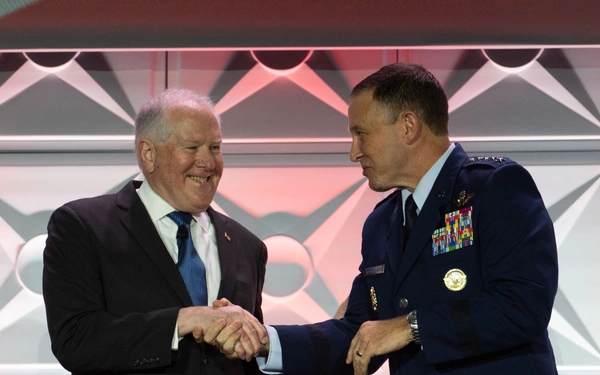The Next-Generation Air Dominance fighter; the Next-Generation Aerial refueling System tanker; a second increment of Collaborative Combat Aircraft drones: Air Force leaders have said in recent years they need them all to be prepared for a future fight with a great power like China.
But speaking at the Airlift/Tanker Association symposium on Nov. 1, Air Force Secretary Frank Kendall admitted the Air Force will have to get “creative” with its future force structure because it cannot afford them all.
“Right now, given our commitments, our resources, and strategic priorities, it’s hard for me to see how we can afford any combination of those new designs,” Kendall said in Grapevine, Texas.
That could prove especially difficult given how the three programs play off one another.
“These three potential new-design platforms are all tied together, all in an Agile Combat Employment context,” Kendall said of NGAD, NGAS, and CCA. They are connected “both operationally and from an affordability perspective, and we are working through a sprint of about four months” to assess “the best combination of capabilities to pursue at various investment levels.”
Having enough resources to build the Air Force that’s needed is “what I worry about most,” Kendall added, noting that “we have to get somewhat creative to adapt our existing force to meet the threat.”
Kendall put a “pause” on the manned NGAD fighter earlier this year, and both he and Chief of Staff Gen. David W. Allvin have said they are unsure if the requirements of the program as set years ago fit with the evolving threat and new unmanned technologies like CCA.
To review those requirements, the service assembled a blue-ribbon panel, including three former Air Force Chiefs of Staff, one former Vice Chairman of the Joint Chiefs, and two leading civilian experts. They are reviewing the evidence now and will recommend a way forward in December.
Kendall said in September he wants the NGAD fighter to cost less than an F-35, which costs about $82 million for the Air Force variant. Having previously pegged the cost of NGAD at “multiple hundreds of millions” of dollars, however, he’s looking for a radical cut in price and capability. A planned contract award for a winner originally scheduled for fall 2024 has been postponed to 2025 at the earliest.
Over the past few decades, the Air Force has had to resort to “a lot of tricks to squeeze more capability out of the same set of resources,” Kendall said. The service has become extremely efficient “by tailoring how we do business to current demands, but it has come at the expense of our ability to deal with our pacing challenge” of China, he said, and the modernization bill has come due.
“There comes a point where you simply need more resources to accomplish more mission. This is particularly true now,” he said. He reiterated recent comments noting that Chinese president Xi Jinping has “told his military: be ready to seize Taiwan by 2027; just over two years from now, even if the U.S. intervenes. I believe that the [People’s Liberation Army] will tell Xi that they are ready.”
Not only are the Air Force’s three marquee programs not all affordable within expected budgets, but the Air Force has other must-pay bills, such as for modernization of two of the three legs of the nation’s nuclear deterrent, Kendall said. Those include the B-21 strategic bomber and Sentinel intercontinental ballistic missile, the latter of which has seen a $40 billion cost overrun in the last year.
Stealthy Tanker
Kendall said China has in recent years invested heavily in precision missiles that can disable air bases and shoot down key assets, such as surveillance, tanker and mobility aircraft, which could hobble U.S. forces operating in the Indo-Pacific theater.
“The increasing threat to our mobility platforms” demands a stealthy tanker—NGAS—that can go with the combat air forces into contested territory and provide the range and staying power they need to prevail, he said.
The need for modernization of mobility forces “will only grow in the years to come. We have made a good start over the last three years, but early-stage development is the lowest-cost part of the new product life cycle,” Kendall said.
In addition to NGAS, officials have spoken on a Next-Generation Air Lift platform, or NGAL, as a replacement for the C-5, C-17 and C-130. Kendall confirmed “we have conceived of a next-generation transport, but at least at this point…we have not moved forward to start that program,” suggesting it would not be affordable within the already-overfull portfolio.
Kendall also said the Space Force needs more money to “grow at the pace needed to be competitive. The entire joint force depends on the success of the Space Force for both its capabilities and its survival.”
Overall, “modernization bills for both Air Force legs of the nuclear triad are coming due in the next few years. We must have robust airbase defense, and we must attack our potential adversaries’ long-range kill chains,” Kendall said. “All of these are absolutely essential for the success of the Air Force and Space Force and the joint force, and all that requires substantial increased investments.”
